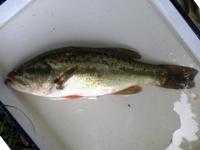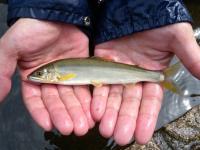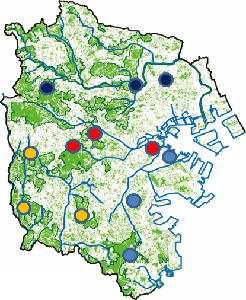The text is from here.
Biodiversity in Yokohama
Last updated on March 1, 2023.
Biodiversity in Yokohama

Yokohama City is a large city with a population of more than 3.7 million (as of December 1, 2018), but there are many forests and farmlands that are cohesive in places close to citizens, mainly in the suburbs. It is characterized by a variety of natural environments due to the sea, rivers, and undulating terrain. However, the green coverage of the city area is on a downward trend, and as of 2009, it is less than 30%.
The following points are the background and issues of the biodiversity crisis in Yokohama City.
- Loss, fragmentation, and deterioration of habitats and habitats due to land use modifications associated with development
- Degraded habitat and growth environment of living creatures due to inadequate management
- Lack of comprehensive accumulation of biological survey data
- Changes in lifestyles and consciousness due to improvements in the convenience of life
- Lack of initiatives that consider biodiversity
As the importance of biodiversity is attracting worldwide attention, it is necessary to share these backgrounds and issues with citizens in the metropolis of Yokohama and connect rich Yokohama-like biodiversity to future generations.
Yokohama City Environmental Management Plan
Invasive creatures in Yokohama

"Invasive creatures (naturalized species)" refers to creatures that were not originally in the area but came from other areas through human activities. There are many creatures that originally lived and did not grow in Yokohama, such as those brought in as pets and became wild, and those that were attached to ships.
Some naturalized species is subject to pest control as damage or potential damage to ecosystems, human life and body, agriculture, forestry and fisheries, but it is difficult and requires a great deal of effort to eradicate naturalized species, which has once spread outdoors.
In order to connect Yokohama-like biodiversity to future generations, the principle of naturalized species is "do not enter," "do not throw it away," and "do not spread it."
Details of invasive creatures in Yokohama
Efforts on Biodiversity at the Institute of Environmental Science
City biota survey
In Yokohama City, we have conducted several biological habitat surveys, mainly by the Institute for Environmental Science. In particular, we conduct surveys on rivers and seas in the city almost every three years since 1973. Please refer to the Environmental Data page for results and reports.
River area

We investigate fish, benthic animals, aquatic plants, attached algae, etc. for the six water systems of rivers flowing through the city, and evaluate the water environment of rivers from creatures.
The survey has been conducted almost every three years since 1973, and the 15th survey was conducted in FY2018 and FY2019.
Details of the River Area Biological Survey
Sea area

We conduct surveys on fish, coastal animals, seaweeds, plankton, etc. at the estuaries, coasts, and inner bays in the city, and evaluate the water environment of the sea from creatures.
The 14th survey was conducted in FY2016.
Details of the marine biota survey
Pond in headwater area

In order to utilize the conservation in the headwater area and its surrounding areas, we conducted a basic survey on water environment in the headwater area from fiscal 2004 to fiscal 2008.
In addition, we carried out biota investigation in four ponds in the city and one educational paddy field in 2010.
Yokohama's headwater Environment Report (March 2009)
headwater Environment - Overview - (March 2009) (PDF: 1,272KB)
Living creatures in the pond in Yokohama (March 2011)
Land area
From fiscal 1986 to fiscal 1990, fiscal 1997 and fiscal 10, the city of Yokohama conducted a survey of biota and ecosystems in the land area of Yokohama, followed by surveys in limited areas such as headwater and parks.
Since fiscal 2012, we have been conducting biota surveys on land areas (plants, mammal, birds, reptile, amphibians and insects) at the 10 major green bases, and urban areas where urbanization is advancing.


| Basin | Survey points |
|---|---|
| Ookagawa Basin | Hitorizawa Citizen's Forest, Kuraki Park, Yokohama Park Yamashita Park |
| Tsurumi River Basin | Shinji Citizen's Forest, Shin-Yokohama Park, Shishigaya Citizen's Forest |
| Katabira River Basin | Children's Nature Park, Jingashita Keikoku Park, Nogeyama Park |
| Sakaigawa Basin | Seya Mukubo Park, Tenno Moriizumi Park, Maioka Park |
Survey by elementary school students

Since fiscal 2013, the Institute for Environmental Science has been conducting surveys of living creatures throughout Yokohama, with the aim of raising citizens' interest in nature and living things in the region and acquiring basic data that contributes to the biodiversity conservation.
About the details of child "lively" creature survey
Accumulation and disclosure of biological data

In Yokohama City, departments other than the Institute for Environmental Science are also conducting surveys on biological habitats. We accumulate the status of these surveys and information on biological habitats, and disclose (partly) data.
List of Reports on Biodiversity
Biological Survey Results Database of Water Areas
Publishing booklets, etc.

The results of the biopharmace survey are published in the survey results report and the summary version of the survey results, but a booklet has been created to make it easier to use and use in the environment in Yokohama.
Reflection to Measures
In implementing measures that take biodiversity into account, it is very important to understand the current status and changes in the living conditions in the city.
The Institute for Environmental Science contributes to the formulation of various plans and guidelines related to biodiversity by analyzing survey results and examining methods for evaluating the environment and ecosystems.
Example 1 Evaluation of the water environment by biological indicators

We evaluate the aquatic environment by setting indicator organisms based on accumulated data from research institutes on aquatic organisms.
- Research reports on water area biological indicators
- Report on Revision of River Biological Indicators
Example 2 Quality evaluation of parks and green spaces
We organized technical requirements for the creation of parks and green spaces in consideration of biodiversity, evaluated the familiar natural environment using the newly developed Ecosystem Soundness Simple Evaluation Method, etc., and announced it in the 2nd Green Technology Forum 2008 (May 2008).
Presentation materials (PDF: 967KB)
List of Biodiversity Indicator Types (PDF: 27KB)
List of healthy ecosystem index species (PDF: 36KB)
Plans and Guidelines for Biodiversity
New "Yokohama Environmental Management Plan" (November 2018)
Yokohama City Water and Green Basic Plan (June 2016)
You may need a separate PDF reader to open a PDF file.
If you do not have it, you can download it free of charge from Adobe.
![]() To download Adobe Acrobat Reader DC
To download Adobe Acrobat Reader DC
Inquiries to this page
Green Environment Bureau Institute of Environmental Science, Environmental Conservation Department
Phone: 045-453-2550
Phone: 045-453-2550
Fax: 045-453-2560
E-Mail address [email protected]
Page ID: 354-346-751







